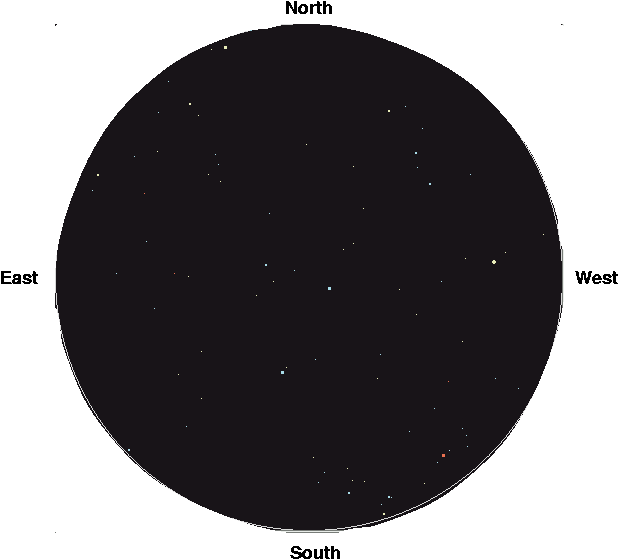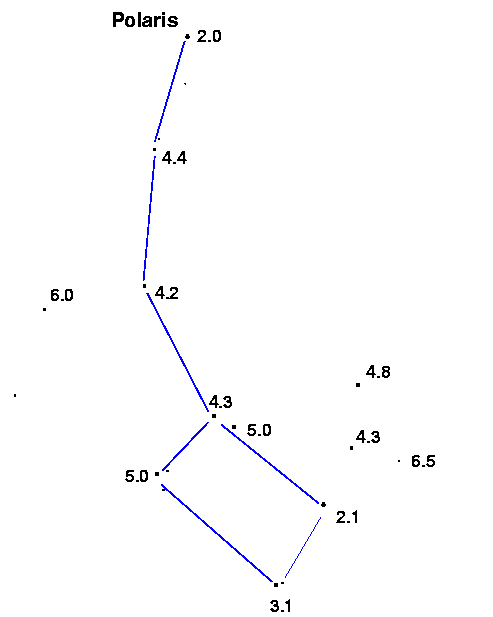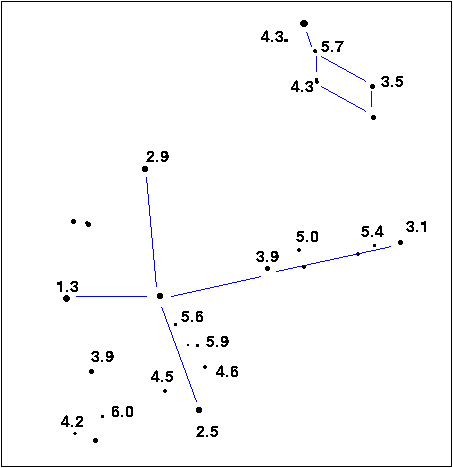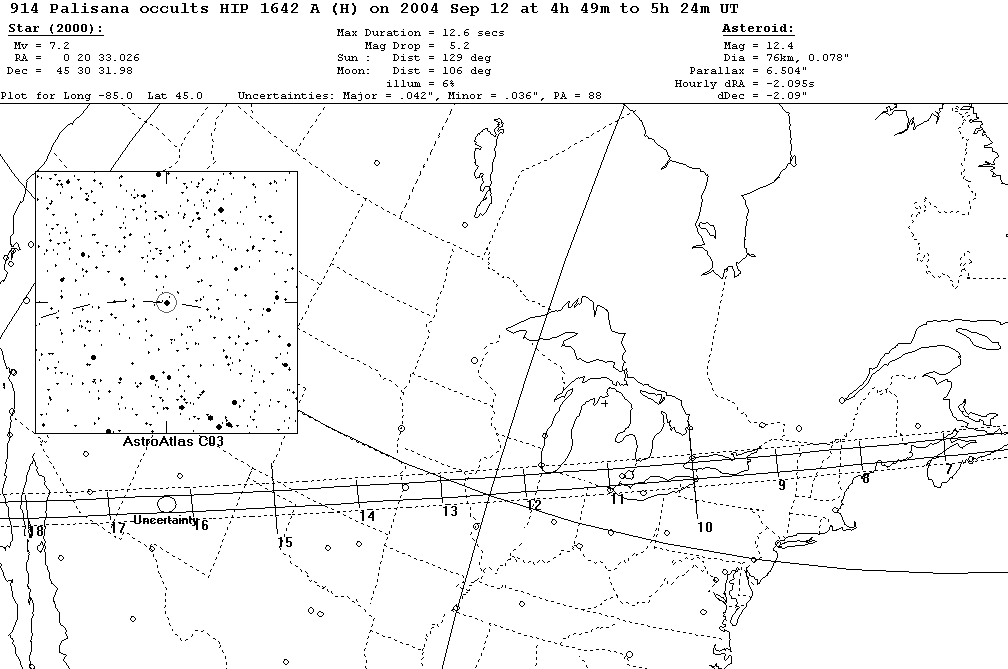
You can find this page on the Internet at
http://spiff.rit.edu/richmond/ritobs/public/sep11_2004/sep11_2004.html
Tonight is one of the rare dark, clear nights in Rochester. We will take advantage of the good conditions to ask you three questions:
Here is a chart showing the location of the brightest stars (down to magnitude 3) in the sky tonight at 9:00 PM.

The set of 3 bright stars nearly overhead is called the "Summer Triangle". Near the horizon in the northwest sky (in the direction of the RIT campus) is the Big Dipper. Use these asterisms to orient yourself. Go outside onto the concrete pad and give your eyes at least 10 minutes to adjust to the dark. Can you make out the Milky Way? Mark its location on this chart.
Astronomers measure the brightness of stars in magnitudes, which are a strange sort of unit: the brighter a star is, the SMALLER its magnitude.
magnitude 0 stars are very bright: Vega, Arcturus magnitude 2 stars are intermediate: most stars in the Big Dipper magnitude 4 stars are pretty faint: handle of the Little Dipper magnitude 6 stars are really faint: (see chart below)
How faint can YOU see? Test yourself three ways.
Test 1: The Little Dipper
Can you see all the stars in the handle of the Little Dipper? All the stars in the bowl? Mark the faintest star you can see on the diagram.

Test 2: Cygnus and Lyra
These two constellations should be nearly overhead. Mark the faintest star you can see on the diagram.

Test 3: The Great Square of Pegasus
Look over the trees to the northeast. You should see a large diamond defined by four bright stars: this is the Great Square of Pegasus, rising up on one corner. How many stars can you see which fall INSIDE the square? Count them, and then use this table to determine the magnitude of the faintest one.
If you can see this many stars the faintest one is
------------------------------ ---------------------
1 mag 4.5
2 - 4 5.0
5 - 7 5.5
8 - 13 6.0
18 - 37 6.5
The number counts were taken from the web site
http://www.astrosurf.com/universia/Nuit2Anglais.htmwhich provides additional tests of limiting magnitude.
Stars are really, really far away from Earth. Even the nearest star is so far that its distance is hard to write in ordinary units: Alpha Centauri (which we can't see from Rochester) is about 38,000,000,000,000 kilometers away. Yikes!
A more convenient unit for the distance to celestial objects is the LIGHT-YEAR: the distance a light ray would travel during a year. The bright star Vega (nearly overhead right now) is about 27 light years away. That means that the light we are seeing now must have left the star 27 years ago.
Here are distances to some of the stars you can see tonight, if you know where to look. Please ask one of the astronomers for help if you can't find one.
Star Distance (light years)
------------------------------------------------
Altair 17
Vega 27
Arcturus 36
Dubhe 120
Antares 190
Deneb 1600
------------------------------------------------
You can see even farther if you consider groups and clusters of stars all together. The following objects are easily visible in a telescope, and may be glimpsed with binoculars or (in the case of M31) even your naked eye. Can you find them? We'll have telescopes pointed to them at various times tonight. Again, ask an astronomer to show you where they are....
Object Distance (light years)
------------------------------------------------
Dumbbell Nebula M27 1,300
Globular Cluster M13 25,000
Globular Cluster M15 34,000
Andromeda Galaxy M31 2,900,000
Triangulum Galaxy M33 3,000,000
------------------------------------------------
Just after 1:00 AM tonight, the asteroid 914 Palisana will pass in front of a star, casting a shadow about 50 miles wide that will fly across the United States. We're going to try to observe it here at the Observatory.

There are some satellites of Earth for us to view tonight, too. I took the following information from the Heavens Above satellite prediction site.

http://www.rit.edu/~ritobs
Wednesday, Oct 27, 2004: Lunar Eclipse The program will begin at 9:30 PM and run until the end of the eclipse, around 12:30 AM.Friday, Nov 19, 2004: The Moon, Uranus and Neptune This program will be early, from 7:00 PM to 9:00 PM, so that we can catch Neptune before it sets in the west.
http://www.seds.org/messier/
http://www.astrosurf.com/universia/Nuit2Anglais.htm
http://www.asteroidoccultation.com/